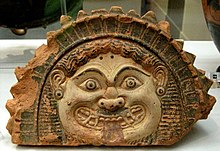মেডুছা
গ্ৰীক কিংবদন্তি অনুযায়ী মেডুছা (প্ৰাচীন গ্ৰীক:Μέδουσα, ৰক্ষক) হৈছে এগৰাকী ৰাক্ষসী।[1] মেডুছাৰ শিৰত চুলিৰ পৰিৱৰ্তে কিছুমান জীৱন্ত সৰ্পৰ স্থান। গৰ্গ নামেৰেও পৰিচিত মেডুছা গৰ্গন নামৰ তিনি পাখিলগা ৰাক্ষসীৰ অন্যতম। মেডুছাৰ চকুৱে চকুৱে চোৱা ব্যক্তিগৰাকী তাৎক্ষণিকভাৱে শিলত পৰিণত হয়। অধিকাংশ সূত্ৰ অনুযায়ী তেওঁ ফৰ্চিছ আৰু চিটোৰ সন্তান।[2] লেটিন লেখক হাইজিনাছৰ মতে তেওঁৰ পিতৃ-মাতৃ গৰ্গন আৰু চিটো।[3]
| মেডুছা | |
|---|---|
 মেডুছাত শিৰেৰে সৈতে ধ্ৰুপদী গ্ৰীক গৰ্গেনিয়ন, খ্ৰীষ্টপূৰ্ব চতুৰ্থ শতিকা | |
| পিতৃ-মাতৃ | ফৰ্চিছ আৰু চিটো |
| সহোদৰ | হেস্পেৰাইড, স্থেনো, ইউৰেল, গ্ৰিয়া, থুছা, স্কাইলা, আৰু লেডন |
| সন্তান | পেগাচাছ আৰু ক্ৰিছেঅ'ৰ |
গ্ৰীক বীৰ পাৰ্চিয়াছে মেডুছাৰ শিৰচ্ছেদ কৰি সেই শিৰ অস্ত্ৰ হিচাপে শত্ৰুক শিলত পৰিণত কৰিবলৈ ব্যৱহাৰ কৰিছিল।[4] পৰৱৰ্তী কালত তেওঁ এই শিৰ এথেনাক তেওঁৰ ঢালত ব্যৱহাৰ কৰিবলৈ প্ৰদান কৰে। ধ্ৰুপদী যুগত (খ্ৰীষ্টপূৰ্ব ৮ম শতিকা-খ্ৰীষ্টিয় ৬ষ্ঠ শতিকা) অশুভ শক্তি আঁতৰ কৰিবলৈ ব্যৱহাৰ কৰা গৰ্গেনিয়ন নামৰ সঁজুলিত মেডুছাৰ শিৰৰ উপস্থিতি দেখা যায়।
কিংবদন্তি
সম্পাদনা কৰকমেডুছা আৰু তেওঁৰ দুই ভগ্নী ষ্ঠেনো আৰু ইউৰাইল জলদেৱতা ফৰ্চিছ (বা ফৰ্কিছ) আৰু চিটোৰ (বা কেটো) সন্তান।[5]
প্ৰাচীন গ্ৰীক মৃ্ৎপাত্ৰ-চিত্ৰকাৰ আৰু ভাস্কৰসকলে মেডুছাক ৰাক্ষসী ৰূপত কল্পনা কৰিছিল যদিও পঞ্চম শতিকাৰ শিল্পীসকলে তেওঁক সুন্দৰী তথা ভয়ংকৰ ৰূপত চিত্ৰায়িত কৰিবলৈ আৰম্ভ কৰে। খ্ৰীষ্টপূৰ্ব ৪৯০-ত ৰচনা কৰা এক কাব্যত গ্ৰীক কবি পিণ্ডাৰে তেওঁক "সুগঢ়ী হনুযুক্ত" বুলি বৰ্ণনা কৰিছে।[6]
পৰৱৰ্তী কালত মেডুছাৰ কিংবদন্তিৰ এক সংস্কৰণত ৰোমান কবি অ'ভিডে তেওঁক পূৰ্বতে এগৰাকী সুন্দৰী কুমাৰী আছিল বুলি উল্লেখ কৰিছে। কিন্তু এথেনা বা মিনাৰ্ভাৰ মন্দিৰত নেপচুন বা প'জাইডনৰ সৈতে যৌন মিলনৰ পিছত এথেনাই শাস্তিস্বৰূপে মেডুছাৰ সুন্দৰ চুলিকোছা ভয়ংকৰ সৰ্পলৈ ৰৰুপান্তৰিত কৰে।[7]
কাহিনীটোৰ বেছিভাগ সংস্কৰণৰ মতে ৰজা পলিডেক্টিছৰ আদেশত বীৰ পাৰ্চিয়াছে মেডুছাৰ শিৰচ্ছেদ কৰে। দেৱতাসকলে এই বিষয়ে সম্ভেদ পায় আৰু এই কাৰ্যত পাৰ্চিয়ছলৈ সাহাৰ্য প্ৰেৰণ কৰে। পাৰ্চিয়াছে এথেনাৰ পৰা এখন আইনাযুক্ত ঢাল, হাৰ্মিছৰ পৰা পাখিলগা পাদুকা, হেফেষ্টিয়াছৰ পৰা এখন তৰোৱাল আৰু হেডিছৰ পৰা অদৃশ্য শিৰোধান লাভ কৰে। তিনি গৰ্গন ভগ্নীৰ ভিতৰত একমাত্ৰ মেডুছাই আছিল মৰণশীল আৰু সেয়ে এথেনাৰ আইনাযুক্ত ঢালত প্ৰতিবিম্ব চাই পাৰ্চিয়াছে মেডুছাৰ শিৰচ্ছেদ কৰে। সেই সময়ত মেডুছা প'জাইডনৰ ঔৰষত গৰ্ভৱতী আছিল। শিৰচ্ছেদ কৰাৰ পিছত মেডুছাৰ দেহৰ পৰা উৰণীয়া ঘোঁৰা পেগেচাছ াৰু হাতত সোণৰ তৰোৱাল লৈ ক্ৰিছেঅ'ৰ নামৰ দৈত্য নিৰ্গত হয়।[8]
অ'ভিডৰ মতে, পাৰ্চিয়াছক টাইটান এটলাছে আক্ৰমণ কৰাৰ চেষ্টা কৰাত মেডুছাৰ খণ্ডিত শিৰৰ সহায়ত পাৰ্চিয়াছে এটলাছক শিলত পৰিণত কৰে।[9] ৰঙা সাগৰৰ প্ৰবালসমূহো মেডুছাৰ শিৰৰ তেজ সাগৰীয় উদ্ভিসসমূহত পতিত হোৱাৰ ফলত গঠিত হোৱা বুলি কাহিনী প্ৰচলিত আছে।
ৰজা পলিডেক্টিছে পাৰ্চিয়াছৰ মাতৃক বলপূৰ্বক বিবাহ কৰে বাবে পাৰ্চিয়াছে ৰজা পলিডেক্টিছকো শিলত পৰিণত কৰে। ইয়াৰ পিছত তেও৬ মেডুছাৰ খণ্ডিত শিৰ এথেনাক অৰ্পণ কৰে।[10]
-
মেডুছাৰ পৌৰাণিক ৰোমান প্ৰতিকৃতি
-
ছিৰিয়াৰ ১ম ছিলিউকাছ নিকাটৰৰ শাসনকালৰ (খ্ৰীষ্টপূৰ্ব ৩১২-২৮০) মুদ্ৰাত মেডুছা
-
টিউনিছিয়াৰ এক সংগ্ৰহালয়ত ৰোমান যুগৰ মোজাইকত মেডুছাৰ চিত্ৰ
-
২য় বা ৩য় শতিকাত নিৰ্মিত ৰোমান প্ৰতিকৃতিত মেডুছা
নাৰীবাদ
সম্পাদনা কৰকবিংশ শতিকাৰ নাৰীবাদীসকলে সাহিত্য আৰু আধুনিক সংস্কৃতিৰ লগতে ভাৰ্ছেক কোম্পানীৰ ল'গ'ত মেডুছাৰ উপস্থিতিৰ পুনৰ্মূল্যায়ন কৰে।[11][12][13][14] "মেডুছা" শব্দটোক প্ৰায়েই কিংবদন্তিৰ চৰিত্ৰটোক প্ৰতিনিধিত্ব কৰাৰ বিপৰীতে একোটা গৰ্গনৰ সামৰ্থ্য তথা শক্তি বা পৰশ্ৰীকাতৰতা অথবা বিদ্বেষ বুজাবলৈ ব্যৱহাৰ কৰা হয়। পূৰ্বতে অতীৱ সুন্দৰী হোৱা স্বত্বেও মেডুছাৰ নাম ৰাক্ষস বুজাবলৈ ব্যৱহৃত হ'বলৈ ধৰে।[15] কিছুক্ষেত্ৰক ইয়াক এগৰাকী নাৰীৰ ক্ৰোধক বুজাবলৈয়ো ব্যৱহাৰ কৰা হয়।[16]
তথ্য সংগ্ৰহ
সম্পাদনা কৰক- ↑ Probably the feminine present participle of medein, "to protect, rule over" (American Heritage Dictionary; compare Medon, Medea, Diomedes, etc.). If not, it is from the same root, and is formed after the participle. OED 2001 revision, s.v.; medein in LSJ.
- ↑ as in Hesiod, Theogony 270, and Pseudo-Apollodorus Bibliotheke, 1.10.
- ↑ "From Gorgon and Ceto, Sthenno, Euryale, Medusa".
- ↑ Bullfinch, Thomas. "Bulfinch Mythology – Age of Fable – Stories of Gods & Heroes". http://classiclit.about.com/library/bl-etexts/tbulfinch/bl-tbulfinch-age-15.htm। আহৰণ কৰা হৈছে: 2007-09-07. "...and turning his face away, he held up the Gorgon's head. Atlas, with all his bulk, was changed into stone."
- ↑ Aeschylus, Prometheus Bound 793–799; Edited and Translated by Alan H. Sommerstein. "Persians, Seven Against Thebes, Suppliants, Prometheus Bound", (Loeb Classical Library) Harvard University Press, 2008, p. 531.
- ↑ (Pythian Ode 12). Noted by Marjorie J. Milne in discussing a red-figured vase in the style of Polygnotos, ca. 450–30 BC, in the Metropolitan Museum of Art; Milne noted that "It is one of the earliest illustrations of the story to show the Gorgon not as a hideous monster but as a beautiful woman. Art in this respect lagged behind poetry." (Marjorie J. Milne, "Perseus and Medusa on an Attic Vase" The Metropolitan Museum of Art Bulletin New Series, 4.5 (January 1946, pp. 126–130) 126.p.)
- ↑ Ovid, Metamorphoses 4.798: "the Sovereign of the Sea attained her love in chaste Minerva's temple" (Brookes More translation) or "in Minerva’s temple Neptune, lord of the Ocean, ravished her" (Frank Justus Miller translation, as revised by G. P. Goold) Whether Ovid means that Medusa was a willing participant is unclear. Hard, p. 61, says she was "seduced"; Grimal, s.v. Gorgons, p. 174, says she was "ravished"; Tripp, s.v. Medusa, p. 363 says she "yielded". In the original Latin text, Ovid uses the verb "vitiasse" which is translated to mean "violate" or "corrupt" line 798.
- ↑ Hesiod, Theogony 281; Pseudo-Apollodorus, Bibliotheke Book II, part iv, nos. 1–3. "The Library: Books 1–3.9." Translated by J.G. Frazer, (Loeb Classical Library), Harvard University Press, 1921 (reprint), pp. 155–161.
- ↑ Ovid, Metamorphoses 4.604–662. Roger Lancelyn Green suggests in his Tales of the Greek Heroes written for children that Athena used the aegis against Atlas.
- ↑ Smith, William; Dictionary of Greek and Roman Biography and Mythology, London (1873). "Perseus"
- ↑ "Versace Medusa Head Logo". gevrilgroup.com. http://gevrilgroup.com/versace/gianni-versace-medusa-logo/.
- ↑ Pratt, A. (1994). Archetypal empowerment in poetry: Medusa, Aphrodite, Artemis, and bears : a gender comparison. Bloomington: Indiana University Press. আই.এচ.বি.এন. 0-253-20865-3
- ↑ Stephenson, A. G. (1997). "Endless the Medusa: a feminist reading of Medusan imagery and the myth of the hero in Eudora Welty's novels."
- ↑ Garber, Marjorie, Vickers, Nancy (2003) The Medusa Reader, Routledge. আই.এচ.বি.এন. 978-0-415-90099-7. p. 7.
- ↑ Garber, Marjorie, Vickers, Nancy (2003) The Medusa Reader, Routledge. আই.এচ.বি.এন. 978-0-415-90099-7. p. 1.
- ↑ Wilk, pp. 217–218.